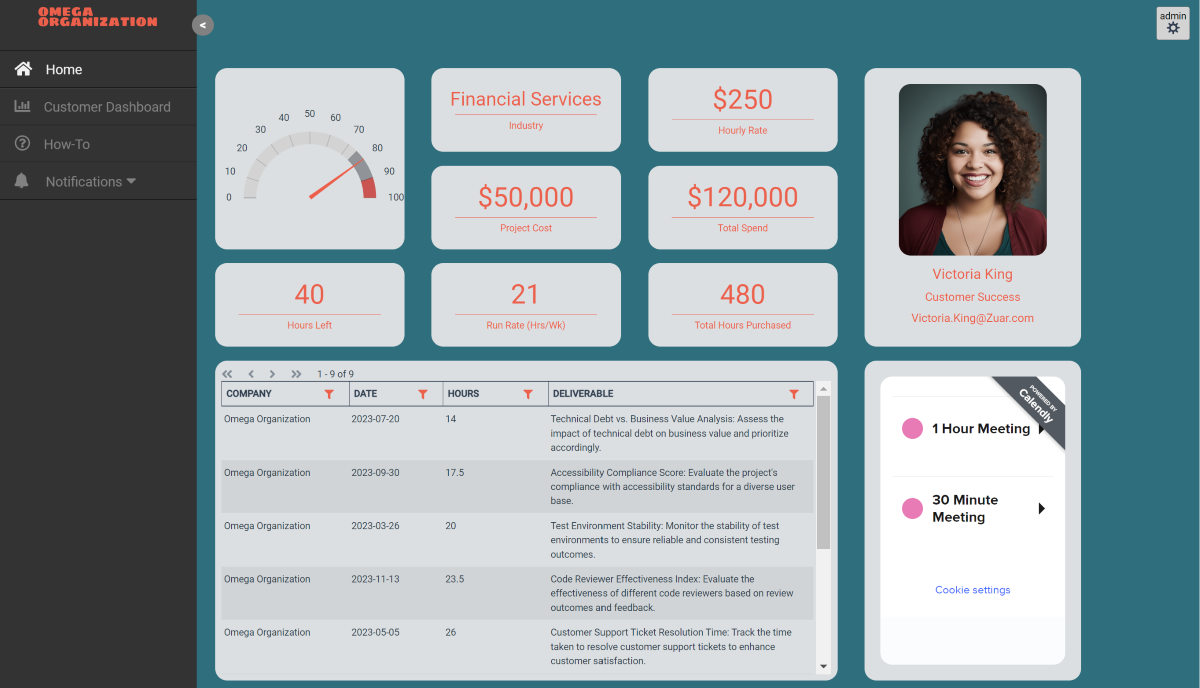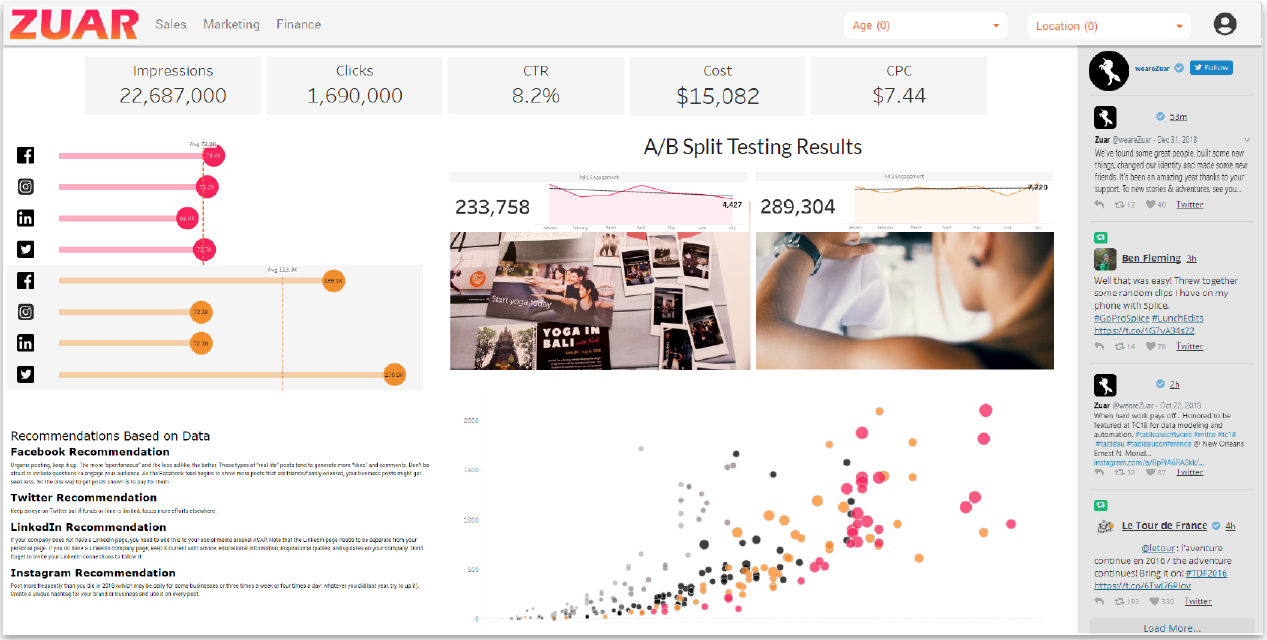10 Common Pitfalls in Embedded Analytics
Discover the top ten challenges of implementing embedded analytics into custom web applications, and learn how Zuar Portal can help you overcome these common pitfalls with robust security, seamless scalability, flexible customization, and more.

Embedded analytics, in this case referring to the integration of analytics into custom web applications (AKA data portals) has become a vital part of many modern business operations.
While it can offer deep insights and drive decision-making, many challenges can emerge during implementation. Avoiding these common pitfalls will ensure a smoother deployment and better user experience.
In this article, we will lay out the top ten challenges that come along with building a custom embedded analytics application. We will also highlight how Zuar's embedded analytics solution, Zuar Portal, can mitigate each challenge.

1. Security & Compliance
Embedding analytics into a data portal brings challenges in maintaining security and compliance with regulations. Ensuring data protection, user access control, and encryption are vital to avoiding breaches and hefty fines, making it crucial to have a solution that addresses these issues from the start.
Challenges
- Data Privacy Concerns: Embedded analytics must comply with regulations like GDPR and HIPAA to ensure sensitive data is protected, with severe penalties for non-compliance.
- Access Control: Implementing strong role-based access control (RBAC) and Single Sign-On (SSO) is essential to restrict data access to authorized users only.
- Vulnerabilities in Embedded Systems: Embedded systems may introduce security gaps if not properly configured, leaving them open to potential attacks or data breaches.
- Weak Encryption: Failing to use strong encryption methods for both data at rest and in transit can expose sensitive information to unauthorized access and cyberattacks.
- Insecure API Connections: APIs are essential for data integration, but poorly secured API connections can become an entry point for attackers to exploit vulnerabilities in the system.
Solving Security & Compliance
To mitigate security and compliance issues, organizations need to ensure their data application is built with robust security features such as encryption, multi-factor authentication (MFA), and compliance with industry regulations.
A solution like Zuar Portal integrates security features such as row-level security and user-based access controls, ensuring data is only accessible to authorized personnel.
Zuar also provides audit trails, which are crucial for maintaining compliance and tracking data access, helping businesses stay secure and compliant as they scale.

2. Performance & Scalability
As the volume of data and users grows, performance can suffer if the underlying infrastructure is not designed to scale efficiently. Businesses must optimize servers, databases, and queries to ensure fast dashboard load times and smooth performance during peak usage.
Challenges
- Slow Loading Dashboards: Dashboards that take too long to load frustrate users and reduce engagement, often caused by inefficient queries or heavy data loads.
- Poor Optimization across Server and Infrastructure: Insufficient optimization of servers and databases can lead to performance bottlenecks, especially during peak usage.
- Resource Drain: Without proper data infrastructure planning, scaling embedded analytics can consume excessive resources, leading to higher costs and reduced system efficiency.
- Poor Planning for Growth: Failing to account for future data growth and user expansion can result in systems that cannot scale effectively, limiting performance and user satisfaction.
- Technical Debt: Short-term fixes for performance issues often create technical debt, making it harder to maintain and scale the system over time without costly overhauls.
Maximizing Performance & Scalability
Performance issues can be mitigated by optimizing the underlying infrastructure, including server load balancing, database tuning, and data caching strategies.
Zuar Portal is designed to scale efficiently, allowing you to start small and expand without significant technical debt or performance bottlenecks.
The portal's backend infrastructure is optimized to handle growing data loads while maintaining fast response times, ensuring dashboards load quickly, even under heavy usage.

3. User Experience & Customization
A seamless and intuitive user experience is essential for embedded analytics success. Dashboards that are hard to navigate, overly complex, or lacking in customization options can frustrate users, lowering adoption rates and diminishing the value of the analytics solution.
Challenges
- Non-Intuitive Dashboards: Dashboards that are difficult to navigate or interpret lead to lower user engagement and hinder effective decision-making.
- Lack of Self-Service: Users expect self-service capabilities to access and manipulate data independently; without these, they rely heavily on IT support, slowing down workflows.
- Limited Customization: Restrictive customization options prevent users from tailoring dashboards to their specific needs, limiting the tool’s usefulness and adaptability.
- Over-complexity: Overloading dashboards with too many features or data points can overwhelm users, making it harder for them to extract meaningful insights efficiently.
Enhancing User Experience & Customization
Improving user experience is key to successful embedded analytics. Creating intuitive dashboards, self-service capabilities, and easy customization options are essential.
Zuar Portal allows businesses to tailor the user interface to their specific needs, offering customizable dashboards and visualization tools.
The portal also empowers users with self-service options, enabling them to manipulate data and generate reports without needing technical expertise, ensuring a smoother and more engaging user experience.

4. Data Management
Effective data management is critical to prevent the creation of data silos and ensure that insights are based on consistent, up-to-date data.
Poor integration of data sources and high data latency can undermine the accuracy and relevance of analytics, leading to flawed decision-making.
Challenges
Inconsistent Data Sources: When data is pulled from multiple sources without proper synchronization, it can lead to discrepancies and unreliable insights. Ensuring data consistency across all systems is critical to maintain accuracy in reporting and decision-making.
Data Silos: Isolated data repositories make it difficult to get a comprehensive view of business performance, limiting the effectiveness of analytics. Breaking down silos by integrating data sources into a unified platform ensures more holistic insights and smoother workflows.
Data Latency: Delays in data processing can result in outdated information, which undermines real-time decision-making. Reducing data latency through optimized pipelines and real-time data syncing is crucial for maintaining the relevance and timeliness of analytics.
Mastering Data Management
To avoid inconsistent data sources and silos, it’s critical to establish a unified data management system with real-time synchronization.
Zuar Portal excels at integrating multiple data sources into a single platform, eliminating silos and ensuring that all data remains consistent and up to date.
Additionally, Zuar enables real-time data streaming, which reduces latency and provides users with timely and reliable insights, crucial for data-driven decision-making.

5. Cost Mismanagement
Budgetary issues arise when organizations underestimate the ongoing costs of maintaining embedded analytics. From infrastructure upgrades to support services, failing to plan for these expenses can lead to cost overruns that diminish the return on investment.
Challenges
Underestimating Maintenance Costs: Many organizations overlook the ongoing costs of maintaining embedded analytics, including infrastructure upgrades, security patches, and user support. Properly budgeting for these recurring expenses is crucial to avoid unexpected financial strain.
Pricing Confusion: Complex pricing structures from vendors can lead to confusion, especially when hidden fees or unclear terms are involved. Gaining a clear understanding of pricing tiers and associated costs upfront helps prevent unpleasant surprises down the line.
Variable Pricing Models: Some analytics platforms use usage-based or variable pricing, which can quickly escalate costs during periods of high demand. Organizations should carefully forecast their usage and choose pricing models that align with their long-term needs to avoid budget overruns.
Honing in Cost Management
Avoiding cost overruns requires clear understanding of both upfront and ongoing maintenance costs.
Zuar Portal offers transparent, scalable pricing models that help organizations anticipate costs related to infrastructure, scaling, and support. By using a solution like Zuar, businesses can avoid unexpected expenses tied to maintenance, updates, or system expansions, ensuring the project remains within budget.

6. Change Management
Implementing embedded analytics often requires significant changes in workflows, which can result in change fatigue for teams. A thoughtful approach to managing these transitions, along with user training and support, is essential to ensure successful adoption without overwhelming staff.
Challenges
Change Fatigue: Constant system updates or process changes can overwhelm users, leading to decreased adoption and engagement. Implementing a structured change management plan with clear communication and phased rollouts helps ease the burden on users and encourages smoother transitions.
Future-Proofing: Failing to plan for future technology or business needs can result in outdated systems that are difficult to upgrade. Building a flexible, scalable infrastructure ensures that the embedded analytics solution can adapt to new trends, tools, and growth without needing a complete overhaul.
Implementing Change Management
Zuar Portal is built with future-proofing in mind, making it easier to implement changes without significant disruption.
Its adaptable framework allows organizations to integrate new features and technologies as business needs evolve, minimizing the impact on users and ensuring longevity.

7. Vendor Lock-In
Relying too heavily on a single vendor for your analytics platform can lead to high switching costs and limited flexibility in the future. To avoid vendor lock-in, it’s important to choose a solution that allows integration with other tools and offers flexible licensing models.
Challenges
Dependency on Single Provider: Relying heavily on a single vendor for analytics solutions can limit flexibility and increase risks if the provider's technology becomes outdated or incompatible.
Inflexible Licensing: Fixed, rigid licensing models can restrict scalability and force companies to pay for features they may not need. Opting for vendors that offer flexible, usage-based licensing allows businesses to adjust as their needs evolve.
Pricing Confusion: Lack of transparency in pricing models can lead to unexpected costs, especially as the business scales. Ensuring a clear understanding of all potential fees, including hidden or usage-based charges, helps organizations budget effectively and avoid financial surprises.
Avoiding Vendor Lock-In
Mitigating vendor lock-in involves choosing platforms that offer flexibility in terms of integration and licensing. Zuar Portal avoids locking organizations into rigid vendor relationships by offering open APIs and flexible licensing models.
The platform is designed to be interoperable with various tools and systems, giving businesses the freedom to switch vendors or integrate new solutions without high switching costs.

8. Integration Issues
Integrating embedded analytics into existing systems can be complicated due to API limitations and compatibility issues. Successful data integration ensures smooth data flow and functionality across different platforms, but if not handled well, it can cause disruptions and incomplete reporting.
Challenges
API Limitations: Many analytics tools rely on APIs for data integration, but limited or poorly designed APIs can restrict the flow of data and reduce functionality.
Compatibility Problems: Integrating analytics across multiple platforms can lead to compatibility issues if the tools aren’t designed to work together.
Data Flow Disruptions: Disruptions in data flow can lead to delays and incomplete insights, affecting the reliability of analytics.
Inconsistent Logging: Poor or inconsistent logging of data and system events can make it difficult to troubleshoot issues and track performance.
Optimizing Data Integration
To address integration challenges, businesses need a solution that supports robust API connections and seamless data flow between systems.
Zuar Portal is designed with flexibility in mind, offering wide-ranging compatibility and API support to ensure smooth integration with third-party applications.
This prevents data flow disruptions and ensures that the entire analytics ecosystem operates efficiently, with consistent data logging across the pipeline.

9. Adoption
For embedded analytics to be fully effective, all stakeholders need to buy into the solution, and that requires thorough training and ongoing support. Poor internal buy-in and a lack of documentation can result in low user engagement, limiting the potential impact of the system.
Challenges
Poor Internal Buy-in: Without strong support from key stakeholders, embedded analytics projects can struggle to gain traction and user adoption.
Training Gaps: Insufficient user training can leave teams unable to fully leverage the capabilities of the analytics tools, limiting its impact.
Continuous Support: Lack of ongoing support can lead to frustration as users encounter issues or need help with advanced features.
Documentation: Poor or outdated documentation makes it difficult for users to troubleshoot problems or learn new features independently.
Maximizing Analytics Adoption
Maximizing adoption requires strong internal buy-in, continuous training, and user support.
Zuar Portal provides detailed documentation, ongoing training, and responsive customer support to help users at every stage of the adoption process.
The platform’s intuitive interface and customizable features also encourage higher engagement, ensuring that both technical and non-technical users can easily adopt the system.

10. Authentication & Authorization
Managing user access with robust authentication and authorization protocols is essential to protect sensitive data. Single Sign-On (SSO), role-based access control, and row-level security must be in place to safeguard against unauthorized access and data breaches.
Challenges
- SSO (Single Sign-On): Implementing SSO simplifies user access by allowing users to log in with one set of credentials across multiple platforms, enhancing security and convenience.
- Row Level Security: Row-level security ensures that users can only access data that is relevant to their role, protecting sensitive information and maintaining compliance.
- User Roles / Groups: Defining user roles and groups allows for precise control over data access, ensuring that users have appropriate permissions based on their responsibilities.
Optimizing Authentication & Authorization
Authentication and authorization issues can be mitigated with robust access control features such as Single Sign-On (SSO) and role-based permissions.
Zuar Portal includes built-in support for SSO and offers advanced user role management to ensure the right people have access to the right data.
With features like row-level security, Zuar ensures data access is restricted based on user roles, preventing unauthorized access and strengthening overall data governance.

Avoiding Embedded Analytics Pitfalls

Addressing these ten common pitfalls in embedded analytics is crucial for ensuring a successful, scalable, and user-friendly implementation.
From security and compliance to performance, scalability, and user adoption, each challenge requires careful planning and strategic solutions.
By leveraging robust platforms like Zuar Portal, organizations can mitigate these risks through strong security features, flexible customization, seamless integration, and scalable infrastructure.
Ultimately, overcoming these hurdles allows businesses to fully unlock the potential of their embedded analytics, driving better decision-making, operational efficiency, and user satisfaction.
Explore Zuar Portal's features by starting a two-week free trial today!




